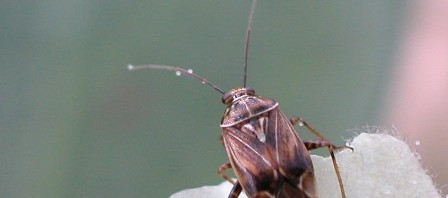 Reports continue of well-above treatment levels of tarnished plant bugs in cotton, especially in fields with 8-10 nodes. There have also been reports of necessary re-treatments. Remember, the suggested treatment threshold for tarnished plant bugs during the first two weeks of squaring is an average of 8 or more bugs per 100 sweeps. You should strive to maintain square retention above 80% by the time you hit bloom. If your square retention is already lower than 80%, you should be more aggressive to protect the remaining fruit. Research has shown that 80% retention is enough to maintain maximum yield potential. Indeed, fields with near perfect retention often yield less than those with 10-20% square loss. Plants can tolerate more plant bugs once you reach the third week of squaring, assuming square retention is adequate, simply because there are more squares. Thus, the threshold increases to 15 bugs per 100 sweeps. There have been a few common questions this week (see below).
Reports continue of well-above treatment levels of tarnished plant bugs in cotton, especially in fields with 8-10 nodes. There have also been reports of necessary re-treatments. Remember, the suggested treatment threshold for tarnished plant bugs during the first two weeks of squaring is an average of 8 or more bugs per 100 sweeps. You should strive to maintain square retention above 80% by the time you hit bloom. If your square retention is already lower than 80%, you should be more aggressive to protect the remaining fruit. Research has shown that 80% retention is enough to maintain maximum yield potential. Indeed, fields with near perfect retention often yield less than those with 10-20% square loss. Plants can tolerate more plant bugs once you reach the third week of squaring, assuming square retention is adequate, simply because there are more squares. Thus, the threshold increases to 15 bugs per 100 sweeps. There have been a few common questions this week (see below).
Do I need to include a knockdown product with an imidacloprid product or Centric? Several folks have asked about using Bidrin which is NOT labeled for use between first square and first bloom. However, I do NOT believe tank mixing with acephate/Orthene or another product is necessary provided you are using sufficient rates. For an imidacloprid product, this means using a minimum of 1.5 oz/acre of (for a 4 lb formulation). You should use the maximum labeled rate when populations are more than twice the threshold. As cheap as the imidacloprid products are now, you should probably use the full labeled rate anytime a spray is justified. In this same high-pressure scenario, I would use 2 oz/acre of Centric. Adding and OP or pyrethroid insecticide will not substantially improve control or residual activity, may flare aphids or spider mites, and is not a particularly good plan for resistance management given these products are used extensively once blooming begins.
Some of this improving “knock down” jargon comes from a few years back when we were using rates below the recommended levels. See my previous blog about comparable insecticide rates for the various imidacloprid products and alternative chemistries recommended prior to bloom. Centric at 1.75-2 oz/acre provides excellent knockdown, and imidacloprid is a close second when used at the full labeled rate. Both should provide acceptable control. If plant bug migration continues after the initial application, be prepared to spray again. Don’t believe sales pitches that promise more than 4-5 days of residual control.
What about adding Diamond? Diamond provides good control of immature plant bugs, and it also has good residual activity. It does not kill adults although it appears to have some negative effects on adult fertility and egg hatching. The prebloom window is a tough fit for Diamond because most of the population is composed of adults. Diamond also has the potential of flaring aphids and spider mites. I would encourage the use of this product in the 7-10 day window before we expect our traditional blow-up of immature plant bugs (which typically occurs 2-3 weeks after first bloom). A good fit for Diamond would be after first bloom when you are seeing a flush of adult plant bugs. You may need to tank mix with something to knock out adults (including stink bugs). I would consider using Diamond in areas where plant bug pressure is historically the highest.
Can I tank mix Ignite with Centric or Imidacloprid? Of course, this only applies to cotton that has tolerance to Ignite (Liberty Link or WideStrike varieties such as Phy375 WRF). I have a test out looking at this now but would not expect any serious interaction between Ignite and insecticides. My testing with OP insecticides such as Bidrin and Acephate for thrips control has not shown any meaningful increase in leaf burn by tank-mixing with Ignite when spraying Phy375 WRF. That does not mean you won’t see some leaf burn from the Ignite component. The need to spray both plant bugs and pigweeds should be the overriding factor when deciding whether to tank mix or not.
What about rainfastness? Most insecticides will require 3-4 hours (and preferably 8-12) to provide adequate control. You should probably retreat any field if a rain falls within 3-4 hours of application, or at the very least, these fields should be checked 2-3 days after application to be sure adequate control was obtained.



One thought on “More on Plant Bugs as the Action Continues”
Comments are closed.